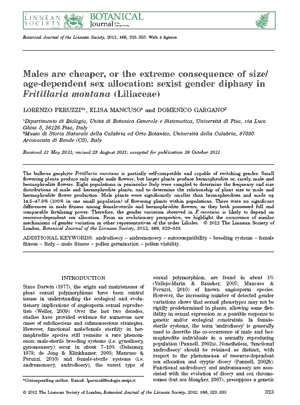NEWS 2012
Males are cheaper, or the extreme consequence of size/age-dependent sex allocation: sexist gender diphasy in Fritillaria montana (Liliaceae)
Lorenzo PERUZZI¹, Elisa MANCUSO¹ and Domenico GARGANO²
Botanical Journal of the Linnean Society 168(3): 323-333 (2012)
doi: 10.1111/j.1095-8339.2011.01204.x
¹Dipartimento di Biologia, Unità di Botanica Generale e Sistematica, Università di Pisa, via Luca Ghini 5, 56126 Pisa, Italy
²Museo di Storia Naturale della Calabria ed Orto Botanico, Università della Calabria, 87030 Arcavacata di Rende (CS), Italy
Abstract
The bulbous geophyte Fritillaria montana is partially self-compatible and capable of switching gender. Small flowering plants produce only single male flowers, but larger plants produce hermaphrodite or, rarely, male and hermaphrodite flowers. Eight populations in peninsular Italy were sampled to determine the frequency and size distributions of male and hermaphrodite plants, and to determine the relationship of plant size to male and hermaphrodite flower production. Male plants were significantly smaller than hermaphrodites and made up 14.5–47.8% (100% in one small population) of flowering plants within populations. There were no significant differences in male fitness among female-sterile and hermaphrodite flowers, as they both possessed full and comparable fertilizing power. Therefore, the gender variation observed in F. montana is likely to depend on resource-dependent sex allocation. From an evolutionary perspective, we highlight the occurrence of similar mechanisms of gender variation in other representatives of the order Liliales.

